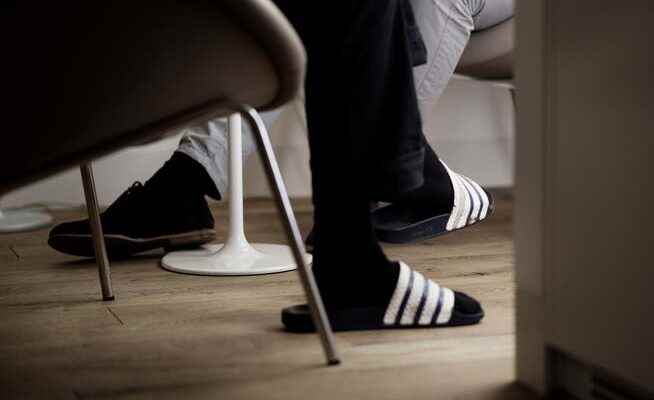Despite the waning of the pandemic and cantonal subsidies, Zurich’s child and adolescent psychiatry is very busy. The government council has now put together another package of measures.
Child and adolescent psychiatry has a problem with young people.
Three years ago, Natalie Rickli took over the Zurich Health Department. There was no pandemic back then. On Monday she told the media: “The situation in child and adolescent psychiatry was tense even then.”
Rickli mentioned a study by the Federal Office of Public Health from 2016. This showed that children and adolescents have to wait much longer for a place in therapy than adults. According to the study, this has to do with an undersupply of mentally ill children.
Then the pandemic hit the country. Covid once again accentuated the undersupply, said Rickli. The number of people reporting mental stress has more than doubled since 2017. This is reflected in the figures from the Clinic for Child and Adolescent Psychiatry and Psychotherapy (KJPP) of the Psychiatric University Clinic Zurich (PUK).
Between 2016 and 2021, the number of outpatient consultations in the KJPP rose from 25,000 a year to over 50,000. Depression has increased particularly sharply. The number of hospitalizations climbed from 250 to 420 a year. Last year, the health department tried to defuse the situation with immediate measures.
Still waiting times
Despite investments of 8 million francs in additional offers and for more staff, the situation remains tense. The government council is now making CHF 5.6 million available for 2023 to continue existing measures and support other offers.
As he states in his application, the implementation of the immediate measures has been delayed due to the shortage of skilled workers. For this reason, waiting times in the outpatient area have not yet been significantly reduced. On the other hand, in emergencies and in the inpatient area.
According to Susanne Walitza, director of the KJPP, all acute emergencies could be treated immediately from May to August. In the outpatient area, the average waiting time was ten days.
“Money alone doesn’t solve the problems,” Rickli said. An expansion of the places and offers is useless if there is a lack of specialists and nurses. The task now is to clearly address the shortage of skilled workers. Walitza pleaded for the promotion of young people during their studies and suggested shortening the six-year training course to become a psychiatrist.
The shortage of skilled workers also affects care, said the KJPP director. Your clinic pursues the goal that the staff can treat the patients promptly and with high quality. The social appreciation of work is indispensable. Flexible working time models are also relevant. And: “We not only have to destigmatize the disorders, but also our profession.”
Both Walitza and Rickli emphasized the importance of prevention and early detection. The Zurich health director said: “It’s about talking more about mental stress.” Rickli mentioned offers for parents concerned about their children’s mental health. “There are no or only very short waiting times for these offers,” she said. And she pointed out that the education department also does a lot to improve the mental health of children and young people.
Also treat children at home
With the additional cantonal funds, a day clinic with ten places of the Integrated Psychiatry Winterthur – Zürcher Unterland (IPW) is supported. The clinic has been open to young people after acute inpatient treatment since the beginning of November. Specialists also take care of young patients for whom outpatient treatment is not enough. According to Rickli, the IPW is closing an important gap at the interface between outpatient and inpatient with the new day clinic.
Rickli described home treatment as an equivalent alternative to conventional hospital treatment. As in adult psychiatry, specialized teams will visit children and young people with serious mental illnesses at home from next year. With home treatment, the aim is to prevent or shorten hospitalizations and relieve inpatient capacities, said Rickli.
The canton of Zurich wants to create additional capacities in 2024. As part of the new hospital planning, Clienia Littenheid AG will receive a performance order for a new ward at the Oetwil am See location next autumn. After moving to Lengg, the University Children’s Hospital Zurich will expand its psychosomatic offering.
According to Rickli, subsidies will also be needed in the medium term in order to better support children and young people and to ensure care: “The canton will continue to have to offer financial support because the tariffs in this area do not cover costs.” She also emphasized: “The better you look at yourself and the more preventive offers are effective, the less outpatient treatment and inpatient stays are needed. In other words, the earlier you start, the faster you will recover. The longer you wait, the longer therapy takes.”
Young middle dissatisfied
The Junge Mitte, which is currently collecting signatures for its cantonal initiative “Healthy Youth Now!”, is dissatisfied with the government council’s expansion steps. The initiative committee writes that the pressure must be maintained. The measures to care for mentally ill children and young people would not do justice to the size and complexity of the crisis.
In its own words, the Junge Mitte initiative calls for an “interdisciplinary approach involving stakeholders from healthcare, education, youth organizations and political decision-makers, with the aim of developing a comprehensive strategy to improve healthcare for mentally ill children and young people”.
In addition, the initiative calls for a waiting period of a maximum of four weeks before medically necessary treatment takes place. This does not apply to severe cases that require immediate treatment, for example in the case of suicidal tendencies.
